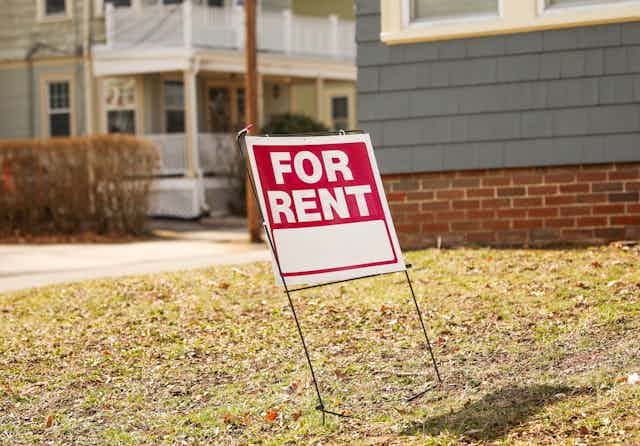Even as housing markets cool in some areas, housing affordability in Canada is the worst in over four decades due, in part, to sustained post-pandemic inflation and comparatively higher interest rates.
According to the Canada Mortgage and Housing Corporation — the federal Crown corporation responsible for administering Canada’s National Housing Act — affordability is defined as mortgage or rent payments that do not exceed more than 30 per cent of a household’s gross monthly income.
If a family makes $50,000 per year before taxes, for instance, anything more than $15,000 per year (or $1,250 per month) spent on rent would put them in an unaffordable situation.
Unaffordable housing situations have been shown to have serious negative outcomes related to communities’ health, crime rates, homelessness, the well-being of children and economic growth.
Accordingly, younger generations are deferring the homeownership dream because of their inability to secure mortgage financing, limited entry-level homeownership options and insufficient incomes.
To date, most research and policy work has focused on homeownership, with little emphasis on understanding the current state of rental affordability. It is becoming increasingly important to address affordability, as demand for rental housing has surged since homeownership is becoming out of reach.
Unaffordability is a growing concern
As economic and strategic management researchers, we were curious about three things: the percentage of individuals or families that are in unaffordable rental situations, how household spending patterns have changed to make ends meet, and whether knowledge of rental economics impacts the likelihood of being in an affordable rental situation.
In our forthcoming study of over 1,000 renters in North America in 2023, we examined household income, monthly expenditures (e.g., rent, food, transportation, clothing, travel, etc.) and knowledge of affordability and basic economics.
We assessed affordability understanding by asking participants if they understood the 30 per cent expenditure rule through a series of questions. Renters were self-identifed and recruited via Prolific, the international survey panel.

By comparing the annual incomes and rental expenditures of households in our sample, results showed that 63 per cent of renters were in unaffordable situations. This means nearly two-thirds of Canadians and Americans are significantly rent-burdened.
Although we expected the results to indicate some unaffordability situations, we did not expect it to be this great.
Solutions to rental crisis
Our data confirms that unaffordability is not just a homeownership issue, but also extends to the rental market. Given that lasting unaffordability has both social and macroeconomic consequences, it is critical that policymakers and industry leaders seek long-term fixes.
But solutions are complex and require a unified approach. Governments must ensure the rental housing supply is efficient to address the increasing affordability concern.
This means Crown corporations and government investments need to be more common. Additionally, civic policies need to promote new housing development and private investment.
For real estate organizations, the demand for affordable rental housing suggests the need to invest in renovating existing accommodations to maintain adequate housing stock and for developers to prioritize new, affordable rental solutions.
The knowledge and rental affordability link
One of the most interesting relationships we found in our data was related to “affordability knowledge” — or the expertise tenants have and use to make economical rental housing choices — and the percentage of income spent on rent.
Specifically, as affordability knowledge increased, the likelihood of being in an unaffordable rental accommodation decreased. The data suggests that the more people know about rental affordability, the better they can make informed rental decisions. This is noteworthy, as most of the recent emphasis has been on how governments, developers and landlords can make housing more affordable.

In addition to affordability efforts by major players in the market, affordability education has an important role to play and should be a top priority for policymakers. Investments in educational campaigns could improve household decision-making and rental affordability.
Historically, households have been good at prioritizing their needs versus wants in economic crises. Unfortunately, our results showed that individuals and families are cutting back on more than just luxury items.
For instance, in all areas of spending, households in unaffordable situations are making budget cuts on everything from groceries to physical activities. In short sprints, these spending re-allocations can be justified and even credited as fiscal responsibility.
But over time, these changes can have lasting health and wellness effects. So while renters have an important role to play, the responsibility doesn’t just fall on their shoulders — strategies require participation from governments and developers as well.
Where to next?
Although the most straightforward path to rental affordability in Canada and the U.S. relates to increasing supply, such as increasing new rental stock, a holistic approach that includes educating renters on affordability and basic housing economics can also be beneficial.
However, this is only a partial remedy for more systemic issue of a lack of affordable rental housing in developed economies in our study of Canadian and American renters.
Addressing the rent affordability crisis requires effective civic policies and planning as well as private sector investment and participation to ensure long-term sustainable housing.
This is a corrected version of a story originally published on Feb. 4. An earlier version of the story said the Canada Infrastructure Bank had invested $150 million in sustainable affordable housing. In fact, the Canada Infrastructure Bank committed $150 million towards sustainable retrofit projects with Avenue Living.

